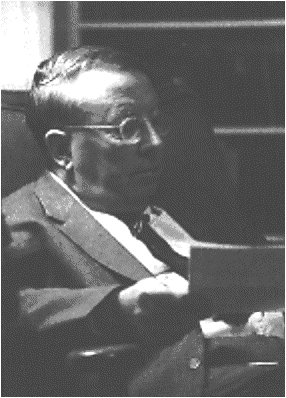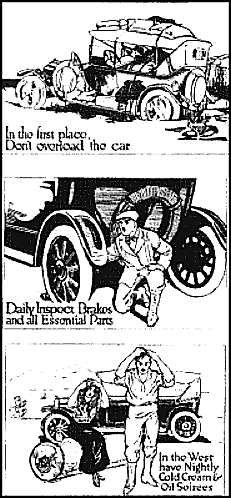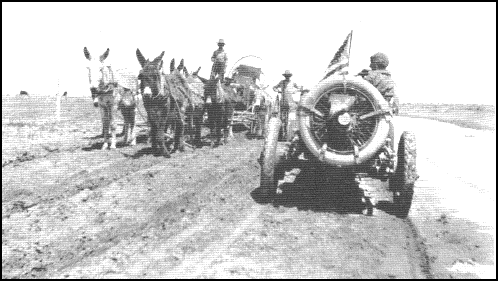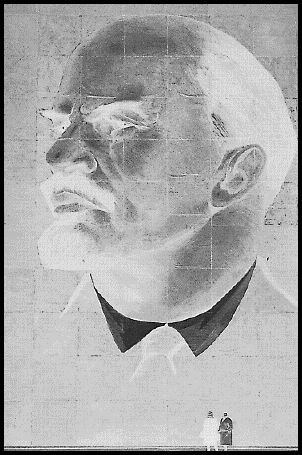Selected Poems
Thom Gunn, Editor
(The Library of America)

In contrast there is the NEA/Guggenheim school of poetasting, those dainty leaky neo-Panhellenics that blossom so ripely in the hot-houses at the New Yorker, Harpers, the Atlantic, the New York Review of Books, the Virginia Quarterly Review, the Mid-West Review. These drab folk always manage to dragoon the university presses or the Augean poetic stable-hands at Knopf, Harcourt Brace, MetroBooks, Ecco/Harper Collins, and Farrar Straus into printing their poems nicely on nice paper with nice covers, no sweat, no tears.
Publishers need have no fear: these are poets with taste. Their verse sports the aroma of magnolia, pipe tobacco, slightly damp tweeds, and burning leaves of New England in the late fall. It is poetry that looks regular and right on the page, and is filled with all the life and vigor of yesterday's mashed potatoes. Writers who form the well-known Anemic School of Verse are probably known to readers of RALPH as we have, over the past decade, basted them as they turn slowly every-so-slowly over the tiny fires kindled by their literary connections. We will not bother at this moment to recount their names. Nor their sins.
But life, and even well-kept university poets, can and do surprise. We have had the experience of rereading many of the poets that were crammed down our throats in school, are sometimes surprised by those whom we thought belonged to the Tweedy-Tidy set who really should have been classed with the Tattered-Terribles. Howard Nemerov is one who recently came thus to surprise us. J. W. Torg is another. Jeremy D. Colon and the Latino Javier Heraud --- along with the early dadaist Edna J. Lacey and her contemporary Roy Fuller --- have now formed part of this newly lively troupe.
Thus it was with some anticipation that we picked up this slim volume of Yvor Winters, hoping for something outside of academic huffery. O woe --- it is not to be.
Reading through the 200 or so poems here reminded us of the origin of the word "poet." The word comes from the Sanskrit cinoti. It means "he heaps up." And Winters is an example of the Neo-Miltonic class of heapery:
Now praise Almena for unchanging pride!
Or
Theseus emerged. Ariadne awaited him...
Or
The minotaur is dead/Pasiphae the white will sin no more...
Or
If I ever pleased the muse/May she not one boon refuse.
Or
The earth for miles is massed with wet...
Or --- to give a more extended and even more sodden example ---
The concept lives, but few men fill the frame;
Greatness is difficult; the certain aim,
The powerful body, and the nervous skill,
The acquiring mind, and the untiring will,
The just man's fury and uplifted arm,
And the strong heart, to keep the weak from harm.
This is the great man of tradition, one
To point out justice when the wrong is done;
To outwit rogue and craven; represent
Mankind in the eternal sacrament ---
Odysseus, with the giant weapon bent.
Now we confess to not being without sin. What with the name Yvor, we always thought that he was a she. Turns out it's "Arthur Yvor Winters." In his (or her) verse, it makes no difference. His name could have been Mudd. The notes tell us that Winters taught at Stanford University for almost thirty years, from 1937 to 1966. If you ever want an example of how a tenured professorship in a fancy-dan college can cook one's poetic goose, it's right here. In black and white.
Record
Setting Trips:
By Auto from
Coast to Coast,
1909 - 1916
Curt McConnell
(Stanford University Press)

It was merciless out there: you could expect to spend a month or two wending your way through the mudheaps of Kansas and Missouri, the snowy reaches of the Continental Divide, and often as not might find yourself up to your ass or at least your brass hubcaps in a muddy river in Western Indiana. This was not pantywaist stuff, and the journals and reports included in The Record Setting Trips makes one think that cross-continental travel might be considered the American equivalent to Antarctic explorations of those years.

Sometimes the details of the dust storms in Brawley, the speed limits in Pennsylvania (24 mph), in Ohio (20 mph), the mud outside Dodge City, the snowstorms at La Junta, Colorado and the bogs in Arizona do get repetitive, but the pictures --- almost a hundred in number --- are a true delight.On top of these are the exploits of the likes of Cannon Ball Baker, one of the more colorful characters involved, who refused to yield the wheel to anyone (he could go 20 hours without sleeping), an eccentric who enjoyed most of all outrunning the small-time cops who were waiting in towns for their share of publicity, if not loot.
This is car history at its best, and from reading it (and thinking on the mysteries of the America out there), we can well understand the urge by many to make the grueling run on wagon trails, across rivers and streams, up and down torturous mountain trails.
The earliest trip listed here --- three men in a 1910 Mitchell Model T --- took 31 days, and ran almost 3700 miles. The last utilizing a 1916 Hudson Super-Six, was a trip from San Francisco to New York and back that took a little over five days each way.
But the most interesting lark of them all (at least to this reader) is scarcely touched on here. It was a trip made by a Jacob Murdock and family. In 1908, "an average motorist in an ordinary, unmodified touring car" drove with mom and kids from coast to coast in thirty-two days. No puffery, no publicity, no reporters, just a guy out on a ramble, out for a look at turn-of-the-century America.
Murdock was a lumberman by trade from Pennsylvania and evidently decided that he and his should take a spin out to the coast and back ... so he did. Which leaves us to wonder how many others in those years just took off, made the onerous trip with no cameras, little publicity, and no more than a bit of chutzpah.
--- Wendy BraniffThe Russian Moment
In World History
Marshall T. Poe
(Princeton University Press)Marshall T. Poe is one of those historians who specializes in bedeviling other historians. Most of those studying the Russian Revolution, he claims, are really "attacking or defending it in ways so obvious as to be pitiable."
There is nothing sadder than the sight of partisans shabbily clothing their mystical politico-religious beliefs in the rags of "science." The entire enterprise represents a black day in modern historiography.
Western historians' greatest failing, as he sees it, is that they have peered at Russian history through western eyes and thus have failed to note the most salient element of those "neolithic farmers with horses," what he calls the "Rus." That is: they withstood 500 years of European aggression, war and invasion, whereas the likes of the Qing Dynasty, the Aztecs, the Ottoman Empire, and the Safavid and Mughal Empires were diseased, eaten up, or swallowed by the gorgons from west of the Dnieper.The Rus were able to survive because of their isolation, their closed borders, the state ownership of the land (including ownership of the peasants that went along with the land), enforced "radical military reforms and the fact that we mostly ignore: that it was a country with no real connection to the sea.
Starting 500 years ago, they created the most effective, efficient governmental system of them all: an autocracy, defined by Poe as "the unconditional rule of one."
Western nations were slowly building semi-democratic systems and power counterbalances (even within autocratic governments) while the Russians were practicing centralized authority in culture, economics, and the military (which evolved into what he calls the "gunpowder" military, as opposed to the "steel" military):
Landlocked and autocratically organized, the Russians fended off the Europeans in the early modern period. Thus began the Russian moment in world history, so called because the Russians alone among large early modern empires maintained their independence from European hegemony.
"In so doing, Poe concludes, "they managed to produce the accouterments of modernity --- a bureaucratic state, industry, mass culture, advanced armies --- in a non-European way. They were the only empire in the world to do so."
Thus we have a country and a culture so far out of the mainstream, cursed with a thin, poor land which was coaxed into production under the harshest of conditions. Their main hope for survival was to avoid being invaded by the Swedes (17 - 18th Centuries), the Polish (17th Century), the French (19th Century), the English and France (ditto) and the Germans (20th).
Readers might suggest that a crucial branch point in Russian history occurred in the late 15th when Muscovy --- autocratic, militarized, and obscurantist --- conquered the free city of Novgorod. The latter was an outward-looking trading city with extensive commercial contacts abroad and a semi-Republican form of government, like the Italian city-states. Russian history would certainly have been different if its leading city had remained this Venice of the north, rather than dreary Moscow, the bailiwick of Ivan the Terrible, Nicholas II and Stalin.
Poe suggests that the Bolsheviks were a natural evolution of previous governmental systems, cut from the same mold: "autocracy, command economics, cultural insularity, and an emphasis on arms."
Clearly there was nothing provisional or limited about the Bolsheviks: Commitment to the party was total, and the goals were nothing short of mystical.
When the soldiers of Kronstadt began to criticize democratic centralism in 1921, Lenin taught the world socialist community three important lessons:
- Socialists would put other socialists to the sword in the name of socialism, and even in very large numbers;
- terror [was shown to] work as well within the party as without; and finally,
- Kronstadt proved that one could be a good international socialist even while murdering other socialists.
The Communists under Stalin, concludes the author, "were guilty of the gravest crimes against humanity. Their regime was illegitimate on those grounds alone."
But it still must be understood that the Bolshevik program achieved its main goals and won the allegiance of most of the subject population. ... The Soviet economy was nothing if not industrial. By the late Soviet period, most Russians worked in factories, and almost everything they consumed came out of those factories. The Soviet military was at certain moments the most advanced in the world. Universal conscription, professional officers' colleges, and a commitment to military research and development made the Soviet armed forces second only to those of the US.
§ § § Poe has constructed an amusing, learned, and sharp little volume. At times it touches on the mystical, sounding not unlike those 19th Century novelists who go on about Mother Russia. The Bolsheviks, for example, whose goals "were nothing short of mystical" are referred to as being not unlike "a radical religious cult ... with the loftiest ends and the cruelest means."
In the final "Bibliographic Note," Poe reports that "Though there are many general interpretations of Russian history, most are not worth reading." Three exceptions, he tells us, are Richard Pipes Russia Under the Old Regime, Richard Hellie's "The Structure of Modern Russian History: Towards a Dynamic Model," and "Muscovite Political Folkways" by Edward Keenan.
In his haste to scorn Russian historians if not historians in general, he ignores some fine narratives that have turned up in the last few years: Ryszard Kapuscinski on the Imperium, James a Billington's The Icon and the Axe and a delicious fictional account of Stalin's life by Richard Lourie, The Autobiography of Joseph Stalin.
--- M. W. Sealy, PhD
